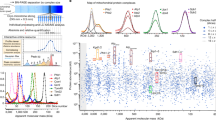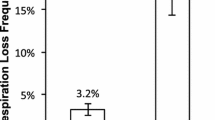Abstract
Studies of yeast mitoribosome assembly have been historically hampered by the difficulty of generating mitoribosome protein-coding gene deletion strains with a stable mitochondrial genome. The identification of mitochondrial DNA-stabilizing approaches allows for the generation of a complete set of yeast deletion strains covering all mitoribosome proteins and known assembly factors. These strains can be used to analyze the integrity and assembly state of mitoribosomes by determining the sedimentation profile of these structures by sucrose gradient centrifugation of mitochondrial extracts, coupled to mass spectrometry analysis of mitoribosome composition. Subsequent hierarchical cluster analysis of mitoribosome subassemblies accumulated in mutant strains reveals details regarding the order of protein association during the mitoribosome biogenetic process. These strains also allow the expression of truncated protein variants to probe the role of mitochondrion-specific protein extensions, the relevance of protein cofactors, or the importance of RNA-protein interactions in functional sites of the mitoribosome. In this chapter, we will detail the methodology involved in these studies.
Access this chapter
Tax calculation will be finalised at checkout
Purchases are for personal use only
Similar content being viewed by others
References
Ferrari A, Del’Olio S, Barrientos A (2021) The diseased mitoribosome. FEBS Lett 595(8):1025–1061. https://doi.org/10.1002/1873-3468.14024
Petrov AS, Wood EC, Bernier CR et al (2019) Structural patching fosters divergence of mitochondrial ribosomes. Mol Biol Evol 36(2):207–219
Jourdain AA, Koppen M, Wydro M et al (2013) GRSF1 regulates RNA processing in mitochondrial RNA granules. Cell Metab 17(3):399–410
Antonicka H, Choquet K, Lin ZY et al (2017) A pseudouridine synthase module is essential for mitochondrial protein synthesis and cell viability. EMBO Rep 18(1):28–38
Tu YT, Barrientos A (2015) The human mitochondrial DEAD-box protein DDX28 resides in RNA granules and functions in mitoribosome assembly. Cell Rep 10(6):854–864
Maiti P, Kim HJ, Tu YT et al (2018) Human GTPBP10 is required for mitoribosome maturation. Nucleic Acids Res 13. https://doi.org/10.1093/nar/gky938
Antonicka H, Sasarman F, Nishimura T et al (2013) The mitochondrial RNA-binding protein GRSF1 localizes to RNA granules and is required for posttranscriptional mitochondrial gene expression. Cell Metab 17(3):386–398
Gopisetty G, Thangarajan R (2016) Mammalian mitochondrial ribosomal small subunit (MRPS) genes: a putative role in human disease. Gene 589(1):27–35
Dalla Rosa I, Durigon R, Pearce SF et al (2014) MPV17L2 is required for ribosome assembly in mitochondria. Nucleic Acids Res 42(13):8500–8515
Reyes A, Favia P, Vidoni S et al (2020) RCC1L (WBSCR16) isoforms coordinate mitochondrial ribosome assembly through their interaction with GTPases. PLoS Genet 16(7):e1008923
Shajani Z, Sykes MT, Williamson JR (2011) Assembly of bacterial ribosomes. Annu Rev Biochem 80:501–526
Barrientos A, Korr D, Barwell KJ et al (2003) MTG1 codes for a conserved protein required for mitochondrial translation. Mol Biol Cell 14(6):2292–2302
Paul MF, Alushin GM, Barros MH et al (2012) The putative GTPase encoded by MTG3 functions in a novel pathway for regulating assembly of the small subunit of yeast mitochondrial ribosomes. J Biol Chem 287(29):24346–24355
Rackham O, Busch JD, Matic S et al (2016) Hierarchical RNA processing is required for mitochondrial ribosome assembly. Cell Rep 16(7):1874–1890
Dennerlein S, Rozanska A, Wydro M et al (2010) Human ERAL1 is a mitochondrial RNA chaperone involved in the assembly of the 28S small mitochondrial ribosomal subunit. Biochem J 430(3):551–558
Metodiev MD, Spahr H, Loguercio Polosa P et al (2014) NSUN4 is a dual function mitochondrial protein required for both methylation of 12S rRNA and coordination of mitoribosomal assembly. PLoS Genet 10(2):e1004110
Brown A, Rathore S, Kimanius D et al (2017) Structures of the human mitochondrial ribosome in native states of assembly. Nat Struct Mol Biol 24(10):866–869
Cipullo M, Gesé GV, Khawaja A et al (2021) Structural basis for late maturation steps of the human mitoribosomal large subunit. Nat Commun 12(1):3673. https://doi.org/10.1038/s41467-021-23617-8
Hillen HS, Lavdovskaia E, Nadler F et al (2021) Structural basis of GTPase-mediated mitochondrial ribosome biogenesis and recycling. Nat Commun 12(1):3672. https://doi.org/10.1038/s41467-021-23702-y
Lenarčič T, Jaskolowski M, Leibundgut M et al (2021) Stepwise maturation of the peptidyl transferase region of human mitoribosomes. Nat Commun 12(1):3671. https://doi.org/10.1038/s41467-021-23811-8
Itoh Y, Khawaja A, Laptev I et al (2022) Mechanism of mitoribosomal small subunit biogenesis and preinitiation. Nature 606:603. https://doi.org/10.1038/s41586-022-04795-x
Cheng J, Berninghausen O, Beckmann R (2021) A distinct assembly pathway of the human 39S late pre-mitoribosome. Nat Commun 12(1):4544. https://doi.org/10.1038/s41467-021-24818-x
Chandrasekaran V, Desai N, Burton NO et al (2021) Visualizing formation of the active site in the mitochondrial ribosome. elife 10. https://doi.org/10.7554/eLife.68806
Saurer M, Ramrath DJF, Niemann M et al (2019) Mitoribosomal small subunit biogenesis in trypanosomes involves an extensive assembly machinery. Science 365(6458):1144–1149
Lenarčič T, Niemann M, Ramrath DJF et al (2022) Mitoribosomal small subunit maturation involves formation of initiation-like complexes. Proc Natl Acad Sci U S A 119(3). https://doi.org/10.1073/pnas.2114710118
Jaskolowski M, Ramrath DJF, Bieri P et al (2020) Structural insights into the mechanism of mitoribosomal large subunit biogenesis. Mol Cell 79(4):629–644
Tobiasson V, Gahura O, Aibara S et al (2021) Interconnected assembly factors regulate the biogenesis of mitoribosomal large subunit. EMBO J 40(6):e106292. https://doi.org/10.15252/embj.2020106292
Bogenhagen DF, Ostermeyer-Fay AG, Haley JD et al (2018) Kinetics and mechanism of mammalian mitochondrial ribosome assembly. Cell Rep 22(7):1935–1944
Zeng R, Smith E, Barrientos A (2018) Yeast mitoribosome large subunit assembly proceeds by hierarchical incorporation of protein clusters and modules on the inner membrane. Cell Metab 27(3):645–656
Desai N, Brown A, Amunts A et al (2017) The structure of the yeast mitochondrial ribosome. Science 355(6324):528–531
Amunts A, Brown A, Bai X et al (2014) Structure of the yeast mitochondrial large ribosomal subunit. Science 343:1485–1489
De Silva D, Fontanesi F, Barrientos A (2013) The DEAD-Box protein Mrh4 functions in the assembly of the mitochondrial large ribosomal subunit. Cell Metab 18:712–725
van Dyck L, Neupert W, Langer T (1998) The ATP-dependent PIM1 protease is required for the expression of intron-containing genes in mitochondria. Genes Dev 12(10):1515–1524
Sanchirico M, Tzellas A, Fox TD et al (1995) Relocation of the unusual VAR1 gene from the mitochondrion to the nucleus. Biochem Cell Biol 73(11–12):987–995
Gancedo JM (1998) Yeast carbon catabolite repression. Microbiol Mol Biol Rev 62(2):334–361. https://doi.org/10.1128/MMBR.62.2.334-361.1998
Visser W, van Spronsen EA, Nanninga N et al (1995) Effects of growth conditions on mitochondrial morphology in Saccharomyces cerevisiae. Antonie Van Leeuwenhoek 67(3):243–253. https://doi.org/10.1007/BF00873688
Morgenstern M, Stiller SB, Lubbert P et al (2017) Definition of a high-confidence mitochondrial proteome at quantitative scale. Cell Rep 19(13):2836–2852. https://doi.org/10.1016/j.celrep.2017.06.014
Kim JH, Roy A, Jouandot D 2nd et al (2013) The glucose signalg network in yeast. Biochim Biophys Acta 1830(11):5204–5210. https://doi.org/10.1016/j.bbagen.2013.07.025
Zaman S, Lippman SI, Zhao X et al (2008) How Saccharomyces responds to nutrients. Annu Rev Genet 42:27–81
Ulery TL, Jang SH, Jaehning JA (1994) Glucose repression of yeast mitochondrial transcription: kinetics of derepression and role of nuclear genes. Mol Cell Biol 14(2):1160–1170
Kayikci O, Nielsen J (2015) Glucose repression in Saccharomyces cerevisiae. FEMS Yeast Res 15(6). https://doi.org/10.1093/femsyr/fov068
Richter-Dennerlein R, Oeljeklaus S, Lorenzi I et al (2016) Mitochondrial protein synthesis adapts to influx of nuclear-encoded protein. Cell 167(2):471–483
Couvillion MT, Soto IC, Shipkovenska G et al (2016) Synchronized mitochondrial and cytosolic translation programs. Nature 533(7604):499–503
Tang JX, Thompson K, Taylor RW et al (2020) Mitochondrial OXPHOS biogenesis: co-regulation of protein synthesis, import, and assembly pathways. Int J Mol Sci 21(11). https://doi.org/10.3390/ijms21113820
Anderson JM, Box JM, Stuart RA (2022) The mitospecific domain of Mrp7 (bL27) supports mitochondrial translation during fermentation and is required for effective adaptation to respiration. Mol Biol Cell 33(1):ar7. https://doi.org/10.1091/mbc.E21-07-0370
Horn D, Fontanesi F, Barrientos A (2008) Exploring protein-protein interactions involving newly synthesized mitochondrial DNA-encoded proteins. Methods Mol Biol 457:125–139
Choi A, Barrientos A (2021) Sucrose gradient sedimentation analysis of mitochondrial ribosomes. Methods Mol Biol 2192:211–226. https://doi.org/10.1007/978-1-0716-0834-0_16
Vignais PV, Stevens BJ, Huet J et al (1972) Mitoribosomes from Candida utilis. Morphological, physical, and chemical characterization of the monomer form and of its subunits. J Cell Biol 54(3):468–492
Gomori G. Preparation of buffers for use in enzyme studies. In: Press A. Methods in enzymology. Elsevier; 1955. p. 138–146
Acknowledgment
This research was supported by the National Institutes of Health grant R35-GM118141 (AB).
Author information
Authors and Affiliations
Corresponding author
Editor information
Editors and Affiliations
Rights and permissions
Copyright information
© 2023 The Author(s), under exclusive license to Springer Science+Business Media, LLC, part of Springer Nature
About this protocol
Cite this protocol
Del’Olio, S., Barrientos, A. (2023). Systematic Analysis of Assembly Intermediates in Yeast to Decipher the Mitoribosome Assembly Pathway. In: Barrientos, A., Fontanesi, F. (eds) The Mitoribosome. Methods in Molecular Biology, vol 2661. Humana, New York, NY. https://doi.org/10.1007/978-1-0716-3171-3_11
Download citation
DOI: https://doi.org/10.1007/978-1-0716-3171-3_11
Published:
Publisher Name: Humana, New York, NY
Print ISBN: 978-1-0716-3170-6
Online ISBN: 978-1-0716-3171-3
eBook Packages: Springer Protocols




